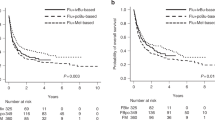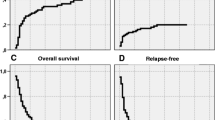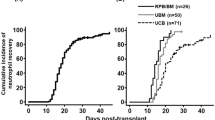Abstract
We report a retrospective single-center analysis of 112 consecutive patients that underwent allogeneic hematopoietic cell transplantation (HCT) after reduced-intensity conditioning (RIC) with fludarabine (FLU) and busulfan (BU) for the treatment of acute myeloid leukemia (AML), myelodysplastic syndrome (MDS) and myeloproliferative syndrome (MPS) from 2005 to 2014. Three-year event-free survival (EFS) and overall survival (OS) were 46 and 58 %, respectively. Patients ≥60 years of age showed a similar outcome compared to younger patients (3-year OS 55 vs. 61 %, p = 0.96; 3-year EFS 46 vs. 46 %, p = 0.82). Cumulative incidence of non-relapse mortality (NRM) at 3 years adjusted for relapse as competing risk was 25 % for patients aged <60 years and 15 % for older patients (p = 0.15). Infusions of higher CD34+ blood stem cell doses were associated with a significantly better outcome in the elderly subgroup (3-year OS 82 vs. 39 %, p = 0.007). Moreover, complete donor chimerism at day +100 was associated with a significantly improved survival (3-year OS 69 vs. 23 %, p = 0.003). In conclusion, our data suggest that RIC with FLU/BU enables long-term disease-free survival even in an elderly patient population. Age has no negative impact on the outcome of allogeneic HCT, and decision for transplant should be based on disease risk and performance status rather than age alone.


Similar content being viewed by others
References
Xie Y, Davies SM, Xiang Y, Robison LL, Ross JA (2003) Trends in leukemia incidence and survival in the United States (1973-1998). Cancer 97(9):2229–2235
Siegel R, Naishadham D, Jemal A (2012) Cancer statistics, 2012. CA Cancer J Clin 62(1):10–29
Buchner T, Berdel WE, Haferlach C, Haferlach T, Schnittger S, Muller-Tidow C, Braess J, Spiekermann K, Kienast J, Staib P, Gruneisen A, Kern W, Reichle A, Maschmeyer G, Aul C, Lengfelder E, Sauerland MC, Heinecke A, Wormann B, Hiddemann W (2009) Age-related risk profile and chemotherapy dose response in acute myeloid leukemia: a study by the German Acute Myeloid Leukemia Cooperative Group. J Clin Oncol 27(1):61–69
Appelbaum FR, Gundacker H, Head DR, Slovak ML, Willman CL, Godwin JE, Anderson JE, Petersdorf SH (2006) Age and acute myeloid leukemia. Blood 107(9):3481–3485
Federmann B, Faul C, Meisner C, Vogel W, Kanz L, Bethge WA (2015) Influence of age on outcome after allogeneic hematopoietic cell transplantation: a single center study in patients aged 60. Bone Marrow Transplant 50(3):427–31
McClune BL, Weisdorf DJ, Pedersen TL, Tunes da Silva G, Tallman MS, Sierra J, Dipersio J, Keating A, Gale RP, George B, Gupta V, Hahn T, Isola L, Jagasia M, Lazarus H, Marks D, Maziarz R, Waller EK, Bredeson C, Giralt S (2010) Effect of age on outcome of reduced-intensity hematopoietic cell transplantation for older patients with acute myeloid leukemia in first complete remission or with myelodysplastic syndrome. J Clin Oncol 28(11):1878–1887
Slavin S, Nagler A, Naparstek E, Kapelushnik Y, Aker M, Cividalli G, Varadi G, Kirschbaum M, Ackerstein A, Samuel S, Amar A, Brautbar C, Ben-Tal O, Eldor A, Or R (1998) Nonmyeloablative stem cell transplantation and cell therapy as an alternative to conventional bone marrow transplantation with lethal cytoreduction for the treatment of malignant and nonmalignant hematologic diseases. Blood 91(3):756–763
Mohty M, Bay JO, Faucher C, Choufi B, Bilger K, Tournilhac O, Vey N, Stoppa AM, Coso D, Chabannon C, Viens P, Maraninchi D, Blaise D (2003) Graft-versus-host disease following allogeneic transplantation from HLA-identical sibling with antithymocyte globulin-based reduced-intensity preparative regimen. Blood 102(2):470–476
Weisdorf D, Zhang MJ, Arora M, Horowitz MM, Rizzo JD, Eapen M (2012) Graft-versus-host disease induced graft-versus-leukemia effect: greater impact on relapse and disease-free survival after reduced intensity conditioning. Biol Blood Marrow Transplant 18(11):1727–1733
Laboure G, Dulucq S, Labopin M, Tabrizi R, Guerin E, Pigneux A, Lafarge X, Leguay T, Bouabdallah K, Dilhuydy MS, Duclos C, Lascaux A, Marit G, Mahon FX, Boiron JM, Milpied N, Vigouroux S (2012) Potent graft-versus-leukemia effect after reduced-intensity allogeneic SCT for intermediate-risk AML with FLT3-ITD or wild-type NPM1 and CEBPA without FLT3-ITD. Biol Blood Marrow Transplant 18(12):1845–1850
Medd PG, Peniket AJ, Littlewood TJ, Pearce R, Perry J, Kirkland KE, Shaw BE, Potter MN, Craddock CF, Milligan DW, Fielding AK, Marks DI, Cook G (2013) Evidence for a GVL effect following reduced-intensity allo-SCT in ALL: a British Society of Blood and Marrow Transplantation study. Bone Marrow Transplant 48(7):982–987
Kohrt HE, Turnbull BB, Heydari K, Shizuru JA, Laport GG, Miklos DB, Johnston LJ, Arai S, Weng WK, Hoppe RT, Lavori PW, Blume KG, Negrin RS, Strober S, Lowsky R (2009) TLI and ATG conditioning with low risk of graft-versus-host disease retains antitumor reactions after allogeneic hematopoietic cell transplantation from related and unrelated donors. Blood 114(5):1099–1109
Brunner AM, Kim HT, Coughlin E, Alyea EP 3rd, Armand P, Ballen KK, Cutler C, Dey BR, Glotzbecker B, Koreth J, McAfee SL, Spitzer TR, Soiffer RJ, Antin JH, Ho VT, Chen YB (2013) Outcomes in patients age 70 or older undergoing allogeneic hematopoietic stem cell transplantation for hematologic malignancies. Biol Blood Marrow Transplant 19(9):1374–1380
Armand P, Gibson CJ, Cutler C, Ho VT, Koreth J, Alyea EP, Ritz J, Sorror ML, Lee SJ, Deeg HJ, Storer BE, Appelbaum FR, Antin JH, Soiffer RJ, Kim HT (2012) A disease risk index for patients undergoing allogeneic stem cell transplantation. Blood 120(4):905–913
Sorror ML, Maris MB, Storb R, Baron F, Sandmaier BM, Maloney DG, Storer B (2005) Hematopoietic cell transplantation (HCT)-specific comorbidity index: a new tool for risk assessment before allogeneic HCT. Blood 106(8):2912–2919
Glucksberg H, Storb R, Fefer A, Buckner CD, Neiman PE, Clift RA, Lerner KG, Thomas ED (1974) Clinical manifestations of graft-versus-host disease in human recipients of marrow from HL-A-matched sibling donors. Transplantation 18(4):295–304
Lee SJ, Vogelsang G, Flowers ME (2003) Chronic graft-versus-host disease. Biol Blood Marrow Transplant 9(4):215–233
McDonald GB, Sharma P, Matthews DE, Shulman HM, Thomas ED (1984) Venocclusive disease of the liver after bone marrow transplantation: diagnosis, incidence, and predisposing factors. Hepatology 4(1):116–122
Jones RJ, Lee KS, Beschorner WE, Vogel VG, Grochow LB, Braine HG, Vogelsang GB, Sensenbrenner LL, Santos GW, Saral R (1987) Venoocclusive disease of the liver following bone marrow transplantation. Transplantation 44(6):778–783
McDonald GB, Hinds MS, Fisher LD, Schoch HG, Wolford JL, Banaji M, Hardin BJ, Shulman HM, Clift RA (1993) Veno-occlusive disease of the liver and multiorgan failure after bone marrow transplantation: a cohort study of 355 patients. Ann Intern Med 118(4):255–267
Sharafuddin MJ, Foshager MC, Steinbuch M, Weisdorf DJ, Hunter DW (1997) Sonographic findings in bone marrow transplant patients with symptomatic hepatic venoocclusive disease. J Ultrasound Med 16(9):575–586
Bader P, Beck J, Frey A, Schlegel PG, Hebarth H, Handgretinger R, Einsele H, Niemeyer C, Benda N, Faul C, Kanz L, Niethammer D, Klingebiel T (1998) Serial and quantitative analysis of mixed hematopoietic chimerism by PCR in patients with acute leukemias allows the prediction of relapse after allogeneic BMT. Bone Marrow Transplant 21(5):487–495
Scrucca L, Santucci A, Aversa F (2007) Competing risk analysis using R: an easy guide for clinicians. Bone Marrow Transplant 40(4):381–387
Baron F, Labopin M, Peniket A, Jindra P, Afanasyev B, Sanz MA, Deconinck E, Nagler A, Mohty M (2015) Reduced-intensity conditioning with fludarabine and busulfan versus fludarabine and melphalan for patients with acute myeloid leukemia: a report from the Acute Leukemia Working Party of the European Group for Blood and Marrow Transplantation. Cancer 121(7):1048–1055
Devillier R, Furst S, Crocchiolo R, El-Cheikh J, Castagna L, Harbi S, Granata A, D’Incan E, Coso D, Chabannon C, Picard C, Etienne A, Calmels B, Schiano JM, Lemarie C, Stoppa AM, Bouabdallah R, Vey N, Blaise D (2014) A conditioning platform based on fludarabine, busulfan, and 2 days of rabbit antithymocyte globulin results in promising results in patients undergoing allogeneic transplantation from both matched and mismatched unrelated donor. Am J Hematol 89(1):83–87
Mohty M, Malard F, Blaise D, Milpied N, Furst S, Tabrizi R, Guillaume T, Vigouroux S, El-Cheikh J, Delaunay J, Le Gouill S, Moreau P, Labopin M, Chevallier P (2015) Reduced-toxicity conditioning with fludarabine, once-daily intravenous busulfan, and antithymocyte globulins prior to allogeneic stem cell transplantation: results of a multicenter prospective phase 2 trial. Cancer 121(4):562–569
Blaise D, Devillier R, Lecoroller-Sorriano AG, Boher JM, Boyer-Chammard A, Tabrizi R, Chevallier P, Fegueux N, Sirvent A, Michallet M, Bay JO, Furst S, El-Cheikh J, Vincent L, Guillaume T, Regny C, Milpied N, Castagna L, Mohty M (2015) Low non-relapse mortality and long-term preserved quality of life in older patients undergoing matched related donor allogeneic stem cell transplantation: a prospective multicenter phase II trial. Haematologica 100(2):269–274
Oudin C, Chevallier P, Furst S, Guillaume T, El Cheikh J, Delaunay J, Castagna L, Faucher C, Granata A, Devillier R, Chabannon C, Esterni B, Vey N, Mohty M, Blaise D (2014) Reduced-toxicity conditioning prior to allogeneic stem cell transplantation improves outcome in patients with myeloid malignancies. Haematologica 99(11):1762–1768
Devillier R, Furst S, El-Cheikh J, Castagna L, Harbi S, Granata A, Crocchiolo R, Oudin C, Mohty B, Bouabdallah R, Chabannon C, Stoppa AM, Charbonnier A, Broussais-Guillaumot F, Calmels B, Lemarie C, Rey J, Vey N, Blaise D (2014) Antithymocyte globulin in reduced-intensity conditioning regimen allows a high disease-free survival exempt of long-term chronic graft-versus-host disease. Biol Blood Marrow Transplant 20(3):370–374
Giver CR, Montes RO, Mittelstaedt S, Li JM, Jaye DL, Lonial S, Boyer MW, Waller EK (2003) Ex vivo fludarabine exposure inhibits graft-versus-host activity of allogeneic T cells while preserving graft-versus-leukemia effects. Biol Blood Marrow Transplant 9(10):616–632
Bahceci E, Read EJ, Leitman S, Childs R, Dunbar C, Young NS, Barrett AJ (2000) CD34+ cell dose predicts relapse and survival after T-cell-depleted HLA-identical haematopoietic stem cell transplantation (HSCT) for haematological malignancies. Br J Haematol 108(2):408–414
Ringden O, Barrett AJ, Zhang MJ, Loberiza FR, Bolwell BJ, Cairo MS, Gale RP, Hale GA, Litzow MR, Martino R, Russell JA, Tiberghien P, Urbano-Ispizua A, Horowitz MM (2003) Decreased treatment failure in recipients of HLA-identical bone marrow or peripheral blood stem cell transplants with high CD34 cell doses. Br J Haematol 121(6):874–885
Tang X, Alatrash G, Ning J, Jakher H, Stafford P, Zope M, Shpall EJ, Jones RB, Champlin RE, Thall PF, Andersson BS (2014) Increasing chimerism after allogeneic stem cell transplantation is associated with longer survival time. Biol Blood Marrow Transplant 20(8):1139–1144
Qin XY, Li GX, Qin YZ, Wang Y, Wang FR, Liu DH, Xu LP, Chen H, Han W, Wang JZ, Zhang XH, Li JL, Li LD, Liu KY, Huang XJ (2014) Quantitative chimerism: an independent acute leukemia prognosis indicator following allogeneic hematopoietic SCT. Bone Marrow Transplant 49(10):1269–1277
Reshef R, Hexner EO, Loren AW, Frey NV, Stadtmauer EA, Luger SM, Mangan JK, Gill SI, Vassilev P, Lafferty KA, Smith J, Van Deerlin VM, Mick R, Porter DL (2014) Early donor chimerism levels predict relapse and survival after allogeneic stem cell transplantation with reduced-intensity conditioning. Biol Blood Marrow Transplant 20(11):1758–1766
Shlomchik WD, Couzens MS, Tang CB, McNiff J, Robert ME, Liu J, Shlomchik MJ, Emerson SG (1999) Prevention of graft versus host disease by inactivation of host antigen-presenting cells. Science 285(5426):412–415
Blazar BR, Murphy WJ, Abedi M (2012) Advances in graft-versus-host disease biology and therapy. Nat Rev Immunol 12(6):443–458
Kashyap A, Wingard J, Cagnoni P, Roy J, Tarantolo S, Hu W, Blume K, Niland J, Palmer JM, Vaughan W, Fernandez H, Champlin R, Forman S, Andersson BS (2002) Intravenous versus oral busulfan as part of a busulfan/cyclophosphamide preparative regimen for allogeneic hematopoietic stem cell transplantation: decreased incidence of hepatic venoocclusive disease (HVOD), HVOD-related mortality, and overall 100-day mortality. Biol Blood Marrow Transplant 8(9):493–500
Bornhauser M, Storer B, Slattery JT, Appelbaum FR, Deeg HJ, Hansen J, Martin PJ, McDonald GB, Nichols WG, Radich J, Woolfrey A, Jenke A, Schleyer E, Thiede C, Ehninger G, Anasetti C (2003) Conditioning with fludarabine and targeted busulfan for transplantation of allogeneic hematopoietic stem cells. Blood 102(3):820–826
Iravani M, Evazi MR, Mousavi SA, Shamshiri AR, Tavakoli M, Ashouri A, Samiee S, Chahardovali B, Alimoghaddam K, Ghaffari SH, Ghavamzadeh A (2007) Fludarabine and busulfan as a myeloablative conditioning regimen for allogeneic stem cell transplantation in high- and standard-risk leukemic patients. Bone Marrow Transplant 40(2):105–110
Dohner H, Estey EH, Amadori S, Appelbaum FR, Buchner T, Burnett AK, Dombret H, Fenaux P, Grimwade D, Larson RA, Lo-Coco F, Naoe T, Niederwieser D, Ossenkoppele GJ, Sanz MA, Sierra J, Tallman MS, Lowenberg B, Bloomfield CD (2010) Diagnosis and management of acute myeloid leukemia in adults: recommendations from an international expert panel, on behalf of the European LeukemiaNet. Blood 115(3):453–474
Acknowledgments
We would like to thank Diana Kilian and Anja Junker for maintaining our HCT database. We would like to thank the technicians from the Chimerism Lab at the Children’s University Hospital in Tübingen for their help to complete the chimerism data. DS, CB, and JS received a Dr. Mildred Scheel Postdoctoral Fellowship from the Deutsche Krebshilfe. DS received a New Investigator Award from the American Society for Blood and Marrow Transplantation.
Conflict of interest
The authors declare that they have no conflict of interest.
Author information
Authors and Affiliations
Corresponding author
Rights and permissions
About this article
Cite this article
Schneidawind, D., Federmann, B., Buechele, C. et al. Reduced-intensity conditioning with fludarabine and busulfan for allogeneic hematopoietic cell transplantation in elderly or infirm patients with advanced myeloid malignancies. Ann Hematol 95, 115–124 (2016). https://doi.org/10.1007/s00277-015-2512-y
Received:
Accepted:
Published:
Issue Date:
DOI: https://doi.org/10.1007/s00277-015-2512-y




